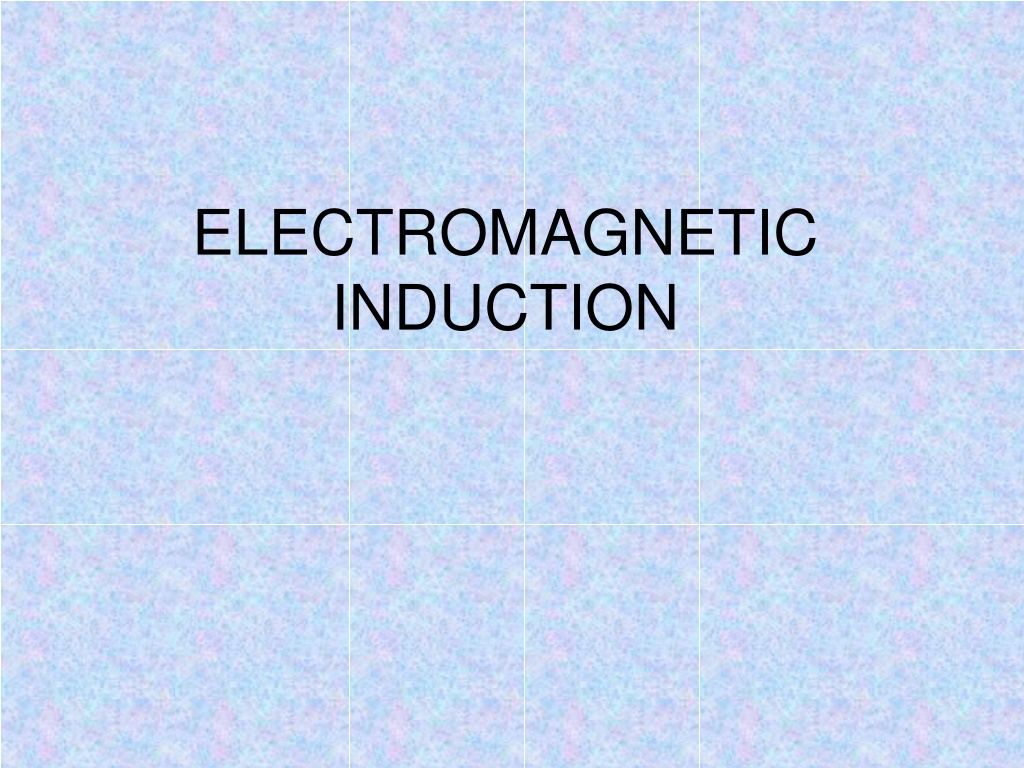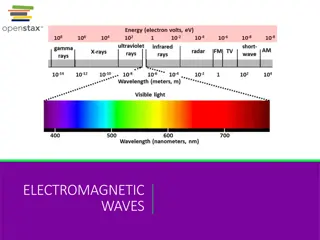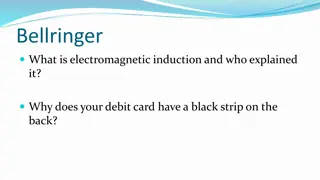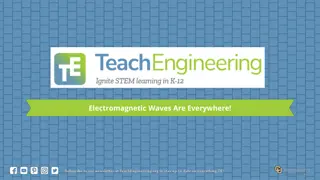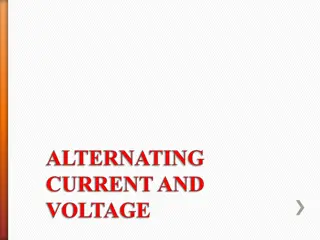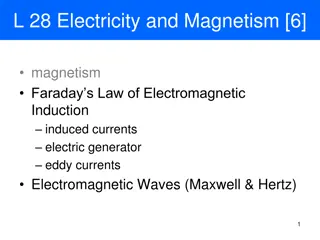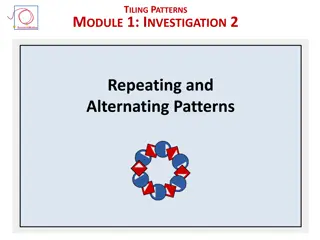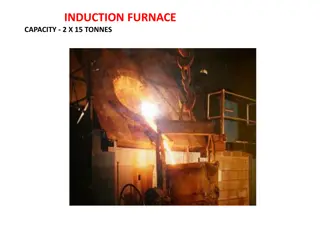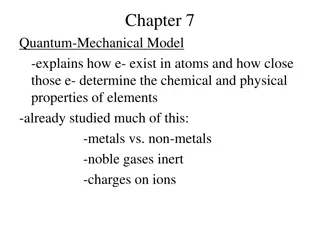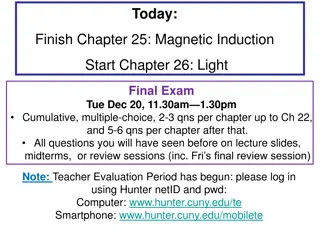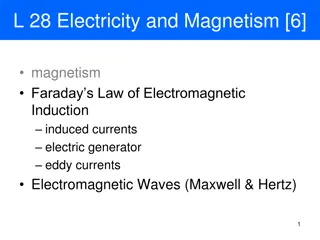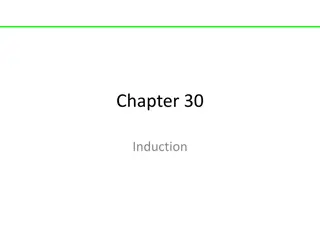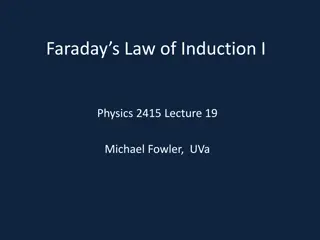Understanding Electromagnetic Induction and Alternating Current Generation
Electromagnetic induction explains how voltage is induced in a conductor or coil when exposed to a magnetic field, with factors affecting the induced voltage. It also covers the generation of electricity through magnet rotation in coils and transformers' role in voltage adjustment. The process is crucial for large-scale energy generation and transmission, highlighting the use of step-up and step-down transformers. Alternating current generators play a vital role in electricity production, primarily utilizing the generator effect to generate power through alternating current.
Uploaded on Oct 04, 2024 | 0 Views
Download Presentation

Please find below an Image/Link to download the presentation.
The content on the website is provided AS IS for your information and personal use only. It may not be sold, licensed, or shared on other websites without obtaining consent from the author. Download presentation by click this link. If you encounter any issues during the download, it is possible that the publisher has removed the file from their server.
E N D
Presentation Transcript
ELECTROMAGNETIC INDUCTION
Specification Electromagnetic induction understand that a voltage is induced in a conductor or a coil when it moves through a magnetic field or when a magnetic field changes through it; and describe the factors which affect the size of the induced voltage describe the generation of electricity by the rotation of a magnet within a coil of wire and of a coil of wire within a magnetic field; also describe the factors which affect the size of the induced voltage describe the structure of a transformer, and understand that a transformer changes the size of an alternating voltage by having different numbers of turns on the input and output sides explain the use of step-up and step-down transformers in the large-scale generation and transmission of electrical energy know and use the relationship: input (primary) voltage / output (secondary) voltage = primary turns / secondary turns Vp/ Vs= np/ ns recall and use the relationship: input power = output power VPIP= VsIsfor 100% efficiency
Electromagnetic induction If an electrical conductor cuts through magnetic field lines, a voltage is induced across the ends of the conductor. If the wire is part of a complete circuit, a current is induced in the wire. This is called electromagnetic induction and is sometimes called the generator effect.
If a magnet is moved into a coil of wire, a voltage is induced across the ends of the coil. If the direction of motion, or the polarity of the magnet, is reversed, then the direction of the induced voltage and the induced current are also reversed. Electromagnetic induction also occurs if the magnetic field is stationary and the coil is moved.
The size of the induced voltage increases when: the speed of the movement increases the strength of the magnetic field increases the number of turns on the coil increases the area of the coil is greater.
Alternating Current Generators Most electricity is produced using the generator effect . The simplest generators and the types used in power stations produce alternating current (A.C.)
This like an electric motor in reverse. As the coil is rotated electromagnetic induction occurs. An alternating voltage is induced in the coil. An alternating current is drawn off through two slip rings. The faster the coil is rotated: - the greater is the amplitude of the voltage and current - the higher is the frequency of the a.c.
Bicycle generator When the wheel turns the magnet is made to rotate next to the fixed coil of wire. Electromagnetic induction occurs and a alternating voltage is induced in the coil. This causes an alternating current to flow to the light bulb of the bicycle.
Question 1 V The graph opposite shows how the voltage of a generator varies in time. Using the same set of axes show how the voltage would vary if the rotational speed of the generator was doubled. time The new voltage will have TWICE the amplitude AND frequency of the original.
Question 2 Choose appropriate words to fill in the gaps below: The _________ effect occurs when a conductor is moved relative to a ____________ field. This is also known as electromagnetic ___________. The greater the relative __________ of the conductor and magnetic field the _______ is the voltage ________. If the conductor is part of a ________ circuit an electric current will flow. ___________ current is produced if the direction of movement is continually _________. WORD SELECTION: alternating generator greater reversed magnetic complete movement induction induced
Question 2 Choose appropriate words to fill in the gaps below: The _________ effect occurs when a conductor is moved relative to a ____________ field. This is also known as electromagnetic ___________. induction generator magnetic The greater the relative __________ of the conductor and magnetic field the _______ is the voltage ________. greater movement induced If the conductor is part of a ________ circuit an electric current will flow. complete ___________ current is produced if the direction of movement is continually _________. reversed alternating WORD SELECTION: alternating generator greater reversed magnetic complete movement induction induced
The transformer A transformer is a device that is used to change one alternating voltage level to another. circuit symbol
Structure of a transformer A transformer consists of at least two coils of wire wrapped around a laminated iron core. PRIMARY COIL of Np turns SECONDARY COIL of Ns turns PRIMARY VOLTAGE Vp SECONDARY VOLTAGE Vs laminated iron core
How a transformer works When an alternating voltage, Vp is applied to the primary coil of Np turns it causes an alternating to flow in this coil. This current causes a changing magnetic field in the laminated iron core which cuts across the secondary coil of Ns turns. Electromagnetic induction occurs in this coil which produces an alternating voltage, Vs.
Question Why can a transformer not change the level of the voltage output of a battery?
Question Why can a transformer not change the level of the voltage output of a battery? A battery produces a steady (DC) voltage. This voltage would cause a constant direct current in the primary coil of a transformer. This current would produce an unchanging magnetic field in the iron core. This unchanging magnetic field would NOT cause electromagnetic induction in the secondary coil. There would therefore be no secondary voltage.
The transformer equation The voltages or potential differences across the primary and secondary coils of a transformer are related by the equation: primary voltage secondary voltage = primary turns secondary turns Vp = Vs Np Ns Transformer - eChalk
Question 1 Calculate the secondary voltage of a transformer that has a primary coil of 1200 turns and a secondary of 150 turns if the primary is supplied with 230V.
Question 1 Calculate the secondary voltage of a transformer that has a primary coil of 1200 turns and a secondary of 150 turns if the primary is supplied with 230V. Vp = Np Vs Ns 230 / Vs = 1200 / 150 230 / Vs = 8 230 = 8 x Vs 230 / 8 = Vs Secondary voltage = 28.8 V
Question 2 Calculate the number of turns required for the primary coil of a transformer if secondary has 400 turns and the primary voltage is stepped up from 12V to a secondary voltage of 48V.
Question 2 Calculate the number of turns required for the primary coil of a transformer if secondary has 400 turns and the primary voltage is stepped up from 12V to a secondary voltage of 48V. Vp = Np Vs Ns 12 / 48 = Np / 400 0.25 = Np / 400 0.25 x 400 = Np Primary has 100 turns
Transformer power transfer equation If a transformer is 100% efficient then the power input to the primary coil is equalled by the power output from the secondary coil. as power = current x voltage then: Ipx Vp=Isx Vs
Question 1 Calculate the primary current if when a transformer is supplied with 230V the secondary provides 4A at a voltage of 13V. Assume that the transformer is 100% efficient.
Question 1 Calculate the primary current if when a transformer is supplied with 230V the secondary provides 4A at a voltage of 13V. Assume that the transformer is 100% efficient. Ipx Vp=Isx Vs Ip x 230V = 4A x13V Ip= 52 / 230 Primary current = 0.226 A
Question 2 Calculate the secondary current from a transformer supplying a secondary voltage of 6V if the primary is supplied with a current of 0.20A at 230V. Assume that the transformer is 100% efficient.
Question 2 Calculate the secondary current from a transformer supplying a secondary voltage of 6V if the primary is supplied with a current of 0.20A at 230V. Assume that the transformer is 100% efficient. Ipx Vp=Isx Vs 0.2A x 230V = Isx6V Is= 46 / 6 Secondary current = 7.67 A
Step-up transformers In a step-up transformer the voltage across the secondary coil is greater than the voltage across the primary coil. The secondary turns must be greater than the primary turns. Use: To increase the voltage output from a power station from 25 kV (25 000 V) to up to 400 kV.
Step-down transformers In a step-down transformer the voltage across the secondary coil is smaller than the voltage across the primary coil. The secondary turns must be smaller than the primary turns. Use: To decrease the voltage output from the mains supply from 230V to 18V to power and recharge a lap-top computer.
Transformers and the National Grid The National Grid is the system of cables used to deliver electrical power from power stations to consumers. The higher the voltage used, the greater is the efficiency of energy transmission. Lower voltages result in higher electric currents and greater energy loss to heat due to the resistance of the cables.
At power stations the output voltage of the generators is stepped up by transformers from 25kV to 132kV. The voltage may be further increased to up to 400 kV for transmission over long distance pylon lines.
The voltage is reduced in stages by step-down transformers to different levels for different types of consumer. The lowest level is 230V for domestic use. The final step- down transformer will be at sub station within a few hundred metres of each group of houses.
Question 1 Why is electrical energy transmitted over the National Grid in the form of alternating current?
Question 1 Why is electrical energy transmitted over the National Grid in the form of alternating current? To maximise efficiency high voltages must be used. Voltage therefore needs to be changed in level. Transformers are needed to change voltage levels. Transformers only work with alternating current.
Question 2 Choose appropriate words to fill in the gaps below: Transformers are used to change one ___________ voltage level to another. They do not work with ____________current. Step-up transformers _________ the voltage because their ___________ coil has more turns than the primary. Transformers are used in the __________ Grid. The _______ output of a power station is increased to up to _______. A high voltage reduces the ________ lost to heat due to the _________ of the power lines. WORD SELECTION: direct National energy secondary resistance alternating 25 kV increase 400 kV
Question 2 Choose appropriate words to fill in the gaps below: Transformers are used to change one ___________ voltage level to another. They do not work with ____________current. alternating direct Step-up transformers _________ the voltage because their ___________ coil has more turns than the primary. secondary increase Transformers are used in the __________ Grid. The _______ output of a power station is increased to up to _______. A high voltage reduces the ________ lost to heat due to the _________ of the power lines. 25 kV National 400 kV energy resistance WORD SELECTION: direct National energy secondary resistance alternating 25 kV increase 400 kV
